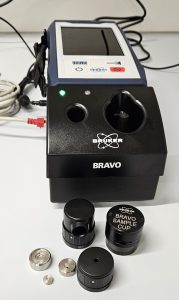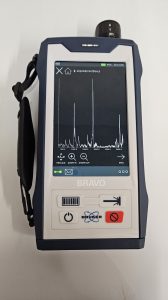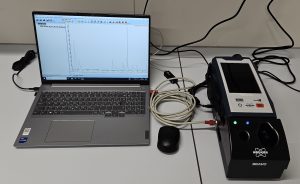Heritage Science Laboratory Ljubljana
Facilities & Services
Facilities & Services
The research facilities of the Heritage Science Lab Ljubljana consist of experimental laboratory facilities and reference research collections. We are continually developing both in close strategic collaboration with the European Research Infrastructure for Heritage Science – Slovenia (E-RIHS.si), of which our Lab is a founding member.
Below is a list of the main laboratory faclities, organised in meaningful headings, available to our researchers and anyone wishing to collaborate with us. We specialise particularly in environmental monitoring and assessment, as well as characterisation of heritage materials. Our excellence has been recognised through the inclusion of our Heritage Macromolecular Lab in the catalogue of services of the EU H2020 IPERION HS project, through which we offer access to our facilities for research collaboration globally.
Organisationally, some of our facilities are managed as part of the Heritage Science Unit of the Centre for Research Infrastructure, and some are managed as part of the Chair for Analytical Chemistry at the Faculty of Chemistry and Chemical Technology, University of Ljubljana.
Environmental Monitoring
Temperature/RH Data Logger
The logger measures and collects temperature and relative humidity (RH) values. It is suitable for outdoor or indoor environments. The temperature sensor range is -40 to 70 °C with a resolution of 0.02 °C, the accuracy is ± 0.25 °C from -40 to 0 °C and ± 0.20 from 0 to 70 °C. The relative humidity sensor range is 0 to 100% from -40 to 70 °C with a resolution of 0.01 % and the accuracy is ± 2.5 % from 10 to 90%, below 10 % and above 90 % is ±5 %. The logger is equipped with Bluetooth, and can be easily configured, read out and the data displayed on our mobile phones or tablets. The logger can calculate minimum, maximum, average and standard deviation.
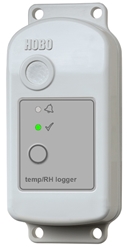
HOBO ® MX2301A Temperature/RH Data Logger
Temperature/RH Miniature Data Logger
The logger measures and collects temperature and relative humidity (RH) values. The temperature sensor range is -20 to 85 °C with an accuracy of 0.1°C ± 0.1 %. The relative humidity sensor range is 0 to 100% with an accuracy of ± 2 % from 10 to 90%, below 10 % and above 90 % is ±5 %. The logger has a USB port for connection to a computer for evaluation of the collected data.
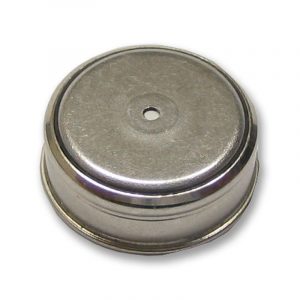
SL54TH-A Miniature Temperature and Humidity Data Logger
TVOC sensor
The sensor measures the amount of total volatile organic compounds. The yellow sensor has a range from 1.5 ppb to 20 ppm TVOC and a lamp energy of 10.6 eV. The sensor allows remote monitoring and recording of TVOCs using a computer and software.
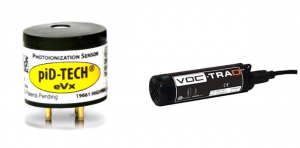
TVOC sensor VOC-TRAQ II
Temperature/Light Data Logger
The logger measures temperature and light in outdoor or indoor environments. The range of the temperature sensor is -20 to 70 °C in air with a resolution of 0.04 °C and an accuracy of ± 0.5 °C. The range of the light sensor is from 0 to 167.731 lux and the accuracy is ± 10 %. The logger is equipped with Bluetooth and can work with data for further analysis. The logger is also waterproof and can be used in various applications.
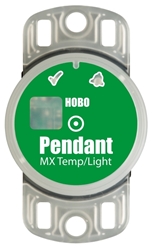
HOBO Pendant MX2202 – Temperature/Light Data Logger
Carbon Dioxide Data Logger
The logger measures carbon dioxide, temperature and relative humidity. The logger consists of non-dispersive, self-calibrating infrared CO2 sensor technology and integrated temperature and RH sensors. The temperature sensor range is 0 to 50 °C with a resolution of 0.024 °C and an accuracy of ± 0.21 °C. The range of the relative humidity sensor is 1 to 90% with a resolution of 0.01 % and an accuracy of ± 2 %. The range of the CO2 sensor is from 0 to 5 000 ppm with an accuracy of ± 50 ppm. The logger is equipped with Bluetooth and minimum, maximum, average and standard deviation can be calculated. The logger also has a USB port and can be used with a computer.
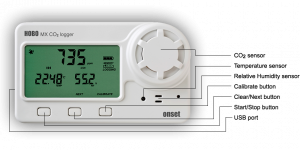
HOBO MX1102 Carbon Dioxide Data Logger
Emission sampling
The MCTE120 is an instrument for the collection of gaseous emissions from solid and liquid samples. The emissions from six microchambers can be collected in parallel using sorbent tubes. As different sorbent materials can be used, the analysis of a wide range of volatile compounds is possible. Collection is followed by extraction by either thermal desorption or liquid-solid extraction. A controlled flow of purified air is used for the sampling of a known volume of gas, allowing for the quantitative analysis of the emissions. The temperature can be regulated from ambient to 120˚C.
The instrument is equipped for the analysis of emissions from bulk samples, or for surface emissions from a specified area. The relative humidity in the microchambers can also be controlled and maintained throughout the collection of the emissions.
Our research
Emissions from materials used for the production, storage and conservation of cultural heritage objects and artefacts.
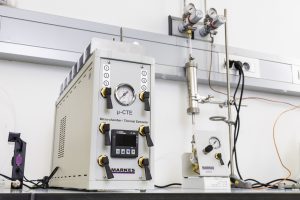
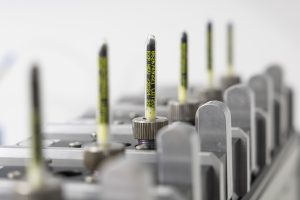
Micro-chamber/Thermal extractor (µCTE™ – MCTE120) (Markes International).
Accelerated Degradation
Climate chambers are used to test the effects of specified environmental conditions (temperature and humidity control) on the tested materials and their properties. They are often used to accelerate the effects of exposure to environmental conditions as accelerated degradation experiments. The conditions for such experiments should be carefully selected to ensure that the degradation process remains the same as during natural degradation.
Two climate chambers with a temperature range of -10 °C to +90 °C and a relative humidity of 10%-98% are available. One of them also acts as a cooling chamber and allows for controlled humidity at low temperatures.
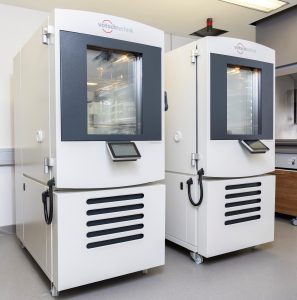
2 chambers; Weistachnik ClimeEvent C/180/0
Flow-Through System With Controlled Atmosphere
With this setup, an atmosphere with the desired humidity, temperature and pollutant concentration is produced and maintained inside a reactor, where the materials to be aged are placed. In this way, the effects of various environmental parameters on material degradation can be studied.
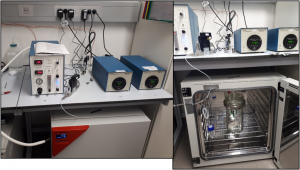
Purpose-made setup, consisting of a humidity generator V-Gen Model 1 (InstruQuest), two pollutant generators Dynacalibrator 150 (Vici) and a heating unit ED 115 (Binder). The flow of compressed air through the system is controlled by mass flow controllers GFC17A (Aalborg) and distributed with PTFE tubing and stainless steel connectors and adapters.
Xenon Weathering Chamber
The SUNTEST CPS+ is used to evaluate changes in the properties of materials caused by sunlight, temperature and humidity in a short period of time. Material changes that occur outdoors or indoors over months or years, such as fading, yellowing or embrittlement, can be simulated in a SUNTEST within weeks. A xenon lamp with a combination of different filters (daylight, window glass, solar, storage light) is used.
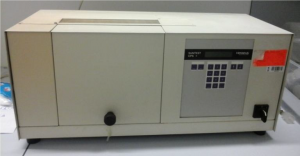
Heraeus-Suntest CPS+
The Oddy test is an accelerated corrosion test widely implemented in cultural institutions as a tool for preventive conservation. Over time, it has shown to be a reliable test for the identification of potentially hazardous materials intended for long-term storage or display. The materials are rated as suitable for permanent use, suitable for temporary use or unsuitable for use, according to the corrosion of coupons, caused by volatile compounds, emitted from the test materials.
The tests are performed at increased temperature and humidity (60 °C and 100% relative humidity for metal coupons and 80 °C for paper coupons) to accelerate the changes that would naturally happen over longer periods of time. The choice of the coupons depends on whether collection materials are predominantly metal or organic.
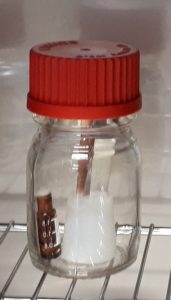
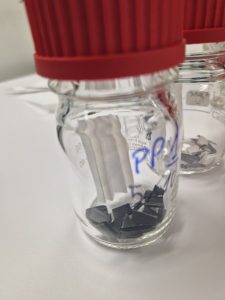
Figure: Oddy test with metal (left) or paper (right) coupons.
Available methods
- 3-in-1 testing with coupons of lead, copper and silver, with visual evaluation of the corrosion
- Testing with paper coupons, evaluation of the loss of the degree of polymerisation of cellulose (based on the article Cross-infection effect of polymers of historic and heritage significance on the degradation of a cellulose reference test material )
Our research
Interlaboratory study of the Oddy test methodology showed our method (“institution IV”) compares favourably.
Separation Techniques
The olfactory detector coupled with the traditional gas chromatography-mass spectrometry system is a powerful analytical technique for identification of odour-active compounds. With this system, chemical separation and odour characterisation of substances can be performed in parallel. After traditional separation in the chromatographic column, the analytes are equally split between the mass detector and the olfactory detector, where the latest uses the human nose identifying the perceived compounds, and impressions are recorded about the quality and intensity of the odours.
The gas chromatograph equipped with a thermal desorption system, in conjunction with a cooled injection, enables highly accurate detection of volatile analytes. It enables reproducible and precise identification of odour-active compounds, including semi-volatile organic compounds (SVOCs).
Available methods
Volatiles in the indoor atmosphere
Emission from different materials
Influence of volatiles on material degradation
Our research
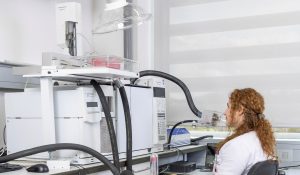
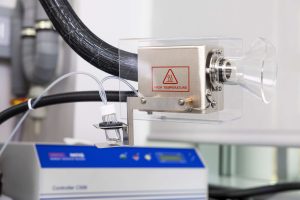
TDS-GC-MS: Gas Chromatograph 7890A coupled to Mass Spectrometer 5975C (Agilent Technologies) with Gerstel Thermal Desorption System TDS in combination with Cooled Injection System CIS, TDS-A Autosampler and Pyrolysis Module PM (Gerstel)
SEC is a type of liquid chromatography, which enables the separation of molecules according to their size. The main characteristic of stationary phases are different sized pores. Smaller molecules enter these pores and therefore they move along the column slowly in comparison to larger molecules. Some molecules are too large to enter the pores and they are excluded and consequently have no retention.
Available methods
- molecular mass distribution for natural and artificial polymers
Our research
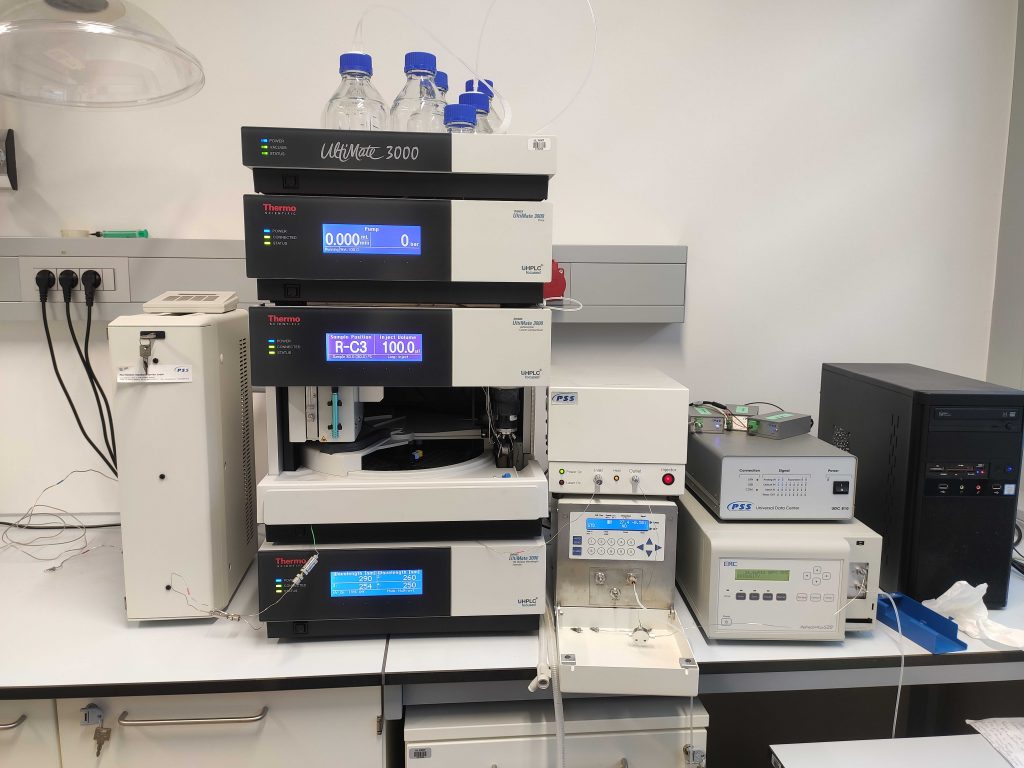
Size-Exclusion Chromatograph with refractive index detector (RefractoMax520), UV detector (RS Variable Wavelength Detector), viscometer and multi angle light scattering detectors; Termo Scientific Dionex UltiMate 3000 UHPLC
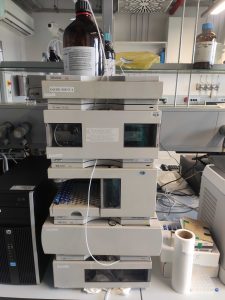
Size-Exclusion Chromatograph with UV/VIS detector, isocratic pump, column thermostat and autosampler; 1100 Series (Hewlett Packard)
Ion chromatography is a liquid chromatography technique in which ions are separated on the basis of their affinity to the ion exchange stationary phase in the column. Both positive and negative ions can be analysed with this technique, in addition to inorganic ions, organic compounds such as amino acids, nucleotides, sugars and proteins can also be analysed if in charged state. As the solvents used for elution reach extreme pH, no metal parts can come into contact with the liquid flow to prevent their corrosion.
Available methods
- Determination of acetic, formic acid, SO2 and NO2 in the indoor atmosphere.
Our research
Novel Pollutant Monitoring at National Museum of Slovenia
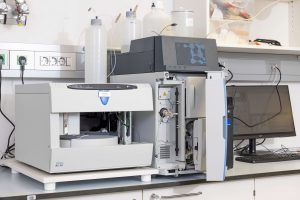

Ion Chromatograph Integrion (Thermo) with Dionex AS-AP autosampler, eluent generator, suppressor and conductivity detectors.
HPLC is a technique, where compounds in a mixed liquid sample are separated, identified and quantified. Usually the solid phase consists of non-polar adsorbent material, which retains compounds until they are eluted with a more polar mobile phase, the duration of retention depending on their molecular properties (mostly polarity). An online detector measures variations in an optical signal, which is correlated to the quantity of the compound. A diode-array detector (DAD) is one of the possible types of detectors, where absorption at multiple wavelengths can be followed at the same time, the range usually encompassing both UV and visible light.
Available methods
- Determination of aldehydes in the indoor atmosphere
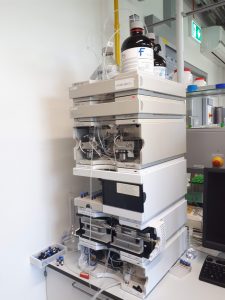
Agilent 1100 Series, including a degasser module, binary pump, autosampler, temperature-controlled column compartment and a DAD detector.
Viscometry
Viscometry is a classical method for polymer characterisation. Viscosity is connected to molecular mass of molecules diluted in the solvent. Commonly vertical capillary is used, and the time needed for a specific volume of solution to flow through the capillary is measured.
Available methods
- degree of polymerisation (DP) for natural and artificial polymers
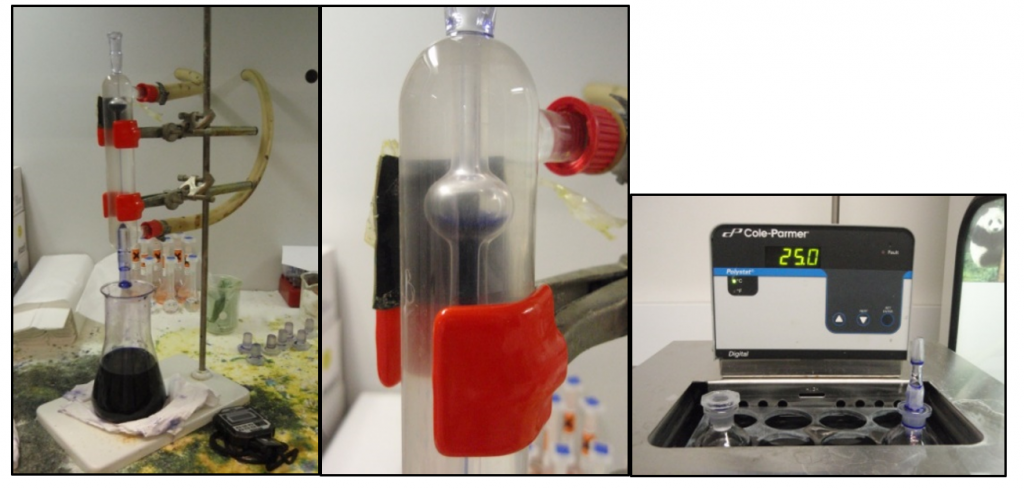
Setup for capillary viscometer
Microscopy
Hirox HRX-01 (HR-2500E)
Hirox HRX-01 (HR-2500E) digital microscope is an advanced imaging tool which provides cutting-edge capabilities in an accessible, user-friendly system. Its high-precision motorized stage, with a 20x to 2500x zoom range, and versatile lighting options like dark field, bright field, polarized light, and UV, enable optimized illumination and produce stunning macro to micro-scale imaging. Intuitive software control features like auto-focus and real-time image tiling simplify complex inspection and documentation tasks. Whether for historical materials, electronics, or biological samples, it produces high-resolution 2D and 3D visuals not possible with basic microscopes.
It has a 5MP sensor which captures crisp 4K images. The ultra-high resolution motorized lens maintains clarity across the entire magnification range. Precise stepper motors coupled with integrated sensors provide microscale position accuracy for superior image quality and quantitative measurements.
To enable versatile inspection, it can be configured with stands like the multi-axis free angle stand for conventional vertical specimen viewing or for adjustable oblique viewing, the horizontal T-stand optimized for vertical objects like paintings, the wheeled flexible arm stand provides mobility, agile repositioning, and an extended working envelope to easily access hard-to-reach spots on oversized samples or objects with unconventional topography.

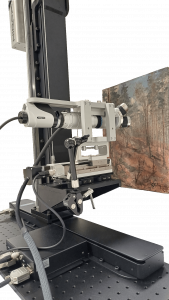
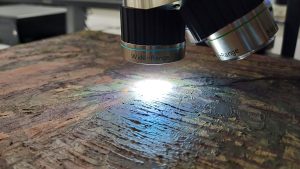
Spectroscopy
Spectrolino GretagMacbeth
The Spectrolino is a portable handheld spectrophotometer that can record reflectance spectra and work as a tristimulus colorimeter. It is used for consistent and accurate colour measurements, so it can be used to distinguish small colour changes. The working spectral range is 380 nm to 730 nm with a resolution 10 nm. The colorimetry measurements can be expressed in common colour space models, such as Lab or XYZ. It is equipped with a neutral filter, that can be exchanged for a D65 filter for approximation to daylight or a polarised filter.
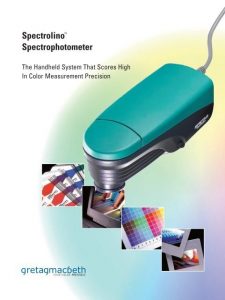
Microfadeometry is a technique that enables us to non-destructively measure the change of colour of an opaque surface caused by visible light (380-780 nm). Due to a small area of illumination, the testing leaves very few traces and can be applied to heritage objects as well as model or sacrificial samples. The colour change is expressed in CIELAB colour space, while spectrometric reflectance data is also collected. Through comparison to Blue Wool standards, the measured objects are ranked according to sensitivity to visible light. Based on the results, object-specific lighting policies can be suggested.
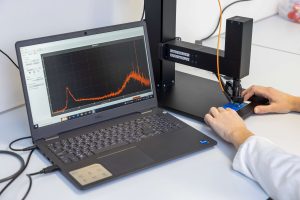
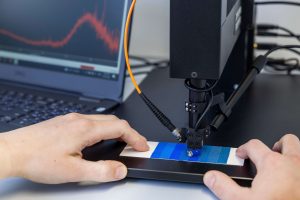
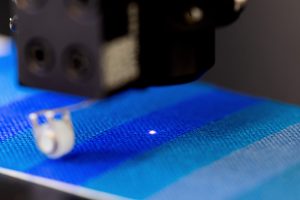
Infrared spectroscopic techniques are useful non-invasive analytical tools for the identification and study of organic and inorganic materials. They are well-established and widely used in various fields with useful applications in many industries and research fields. The infrared energy of the electromagnetic spectrum is usually divided into three regions the near, mid and far infrared from the visible spectrum.
Fourier Transform Infrared (FTIR) spectroscopy
It is a vibrational spectroscopy technique in the mid-infrared region ranging approximately 4000–400 cm−1. FTIR provides useful chemical structural information and allows for performing qualitative and quantitative analysis. A beam of IR light is used to excite molecular vibrations, so absorption occurs at frequencies characteristic of the sample’s structure generating an absorbance (or transmittance) spectrum.
FTIR spectroscopy has three main measurement techniques, it can work in Transmission, Attenuated Total Reflection (ATR) and Reflection. Each technique needs a few preparations and adjustments to obtain the anticipated results.
In the ATR technique, which is more oriented towards the surface analysis, the light only interacts with the first few microns in the sample, the sample is pressed to be in contact with a crystal with high refractive index material like diamond, zinc selenide (ZnSe) and germanium (Ge). The sensitivity depends on the properties of the sample and the refractive index of both the crystal and the sample. This technique requires little to no sample preparation to create an IR spectrum.
Bruker Alpha II FTIR spectrometer using external PC with OPUS software sampling module ATR:
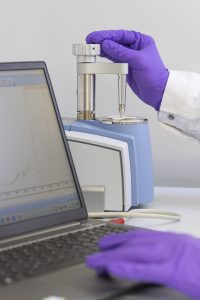
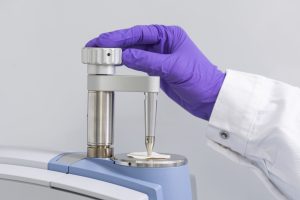
In the Reflection technique, the spectrum is collected from the light that is reflected off the surface of the sample. It is a contactless technique, that works with solid samples with no need for any preparations. The instrument’s direction can be flexibly adjusted, and the measurement can be guided by an integrated video camera to find the area of interest and record it.
Bruker Alpha II FTIR spectrometer using external PC with OPUS software sampling module reflectance (contactless, video-assisted):
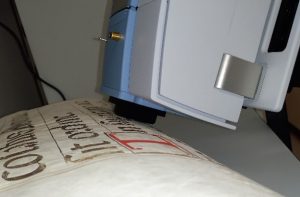
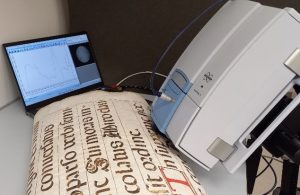
Near Infrared (NIR) Spectroscopy
NIR Spectroscopy has been successfully used in studies of a variety of heritage materials as it reflects combination and overtone vibrations associated with C–H, O–H and N–H chemical bonds. It uses near-infrared light in the range of 780 – 2500 nm to excite molecular vibrations. It is a non-destructive technique that requires no sample preparation and has deeper penetration compared to mid-infrared radiation. Spectral data are typically more complex that is collected from the light scattered off and through the sample. Direct assignment of the spectrum features to chemical compounds is difficult however It can be used to classify or estimate properties of unknown samples when combined with multivariate data analysis based on a correlation with physical properties obtained from reference analytical methods applied to well-characterized and representative samples.
Portable UV-VIS-NIR ASD LabSpec® 5000 Spectrometer, equipped with a built-in light source, works with a fiber-optic probe that has a diameter of approx. 3 mm with Indico™ Pro software (version 6.0.3):
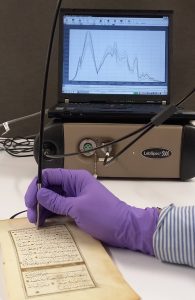
Recently, spectral imaging techniques, such as Multispectral (MSI) and Hyperspectral Imaging (HSI), have gained importance in the field of heritage conservation.
Heritage objects exhibit compositional inhomogeneity due to the varied materials and processes involved in their production. Hyperspectral imaging, in particular, has emerged as a non-destructive, non-contact and powerful tool by combining imaging with material characterization, expanding spectroscopic applications from spot analysis to the examination of the entire surface of an object. This approach consequently provides valuable information about the distribution of material properties across the object’s surface, enabling detailed studies of its physical and chemical composition.
Spectral data are collected by a translational stage equipped with a pushbroom scanner (SC-A3) developed by Clyde Hyperspectral Imaging and Technology Ltd. (ClydeHSI). The system operates in the range of 400-2500 nm and can simultaneously hold one or two hyperspectral cameras. The VNIR camera covers the range of 400-1000 nm with a spectral resolution <=3 nm, while the SWIR camera covers 900-2500 nm with a spectral resolution of <=12 nm. Both cameras offer high frame rates of up to 420 and 450 lfps (line per frame), respectively. A set of objective lenses is available for each camera, offering various levels of detail and spatial resolution tailored to the materials under investigation.
The current setup of the system allows the scanning stage to accommodate objects up to A3 size (~30 × 40 cm). Halogen lamps with adjustable angles and heights are used to illuminate the object, ensuring optimal imaging conditions.
A portable and fully motorized setup (SC-XY-1500) is also available, capable of holding up to two Hyperspectral cameras. This setup enables scanning of larger objects, up to 1.5 x 1.5 m, depending on the specific requirements of the application.
A custom software, SpectraSENS, developed by ClydeHSI, offers a user-friendly interface for controlling the HSI system, as well as for data acquisition, visualization, and subsequent analysis of the acquired hyperspectral data.
Hyperspectral
Imaging System (Translational Stage-SC-A3):
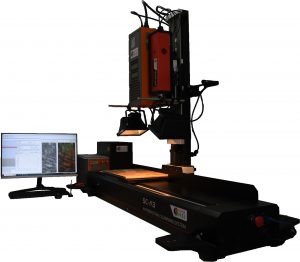
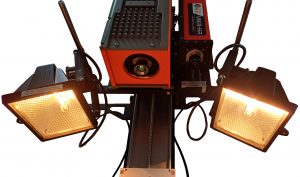
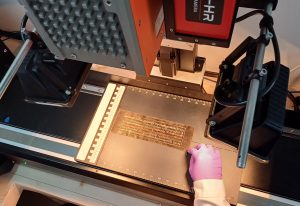
Hand-held Bruker BRAVO Raman spectrometer is used for acquiring Raman spectra of various organic/inorganic compounds and materials. Duo laser excitation (785 and 852 nm wavelength lasers) enables high sensitivity across the 3000–170 cm–1 spectral range. High performance of instrument combined with user-friendly OPUS software allows fast materials’ verification and identification of unknown compounds.
